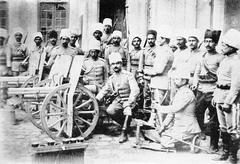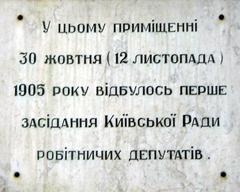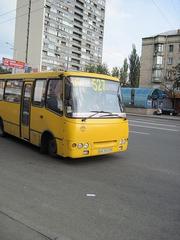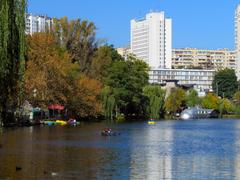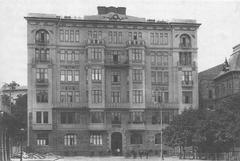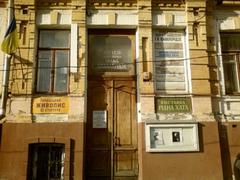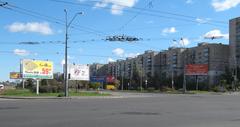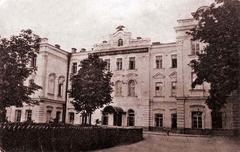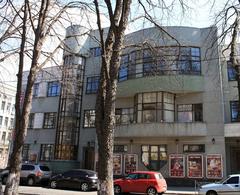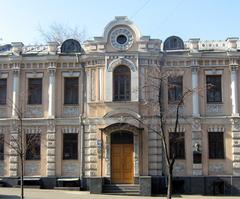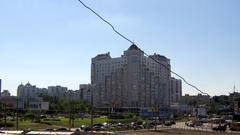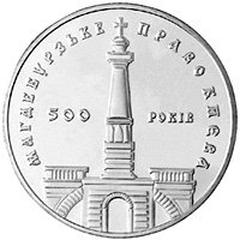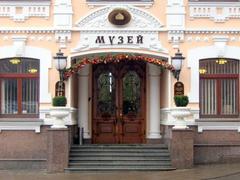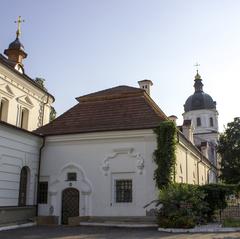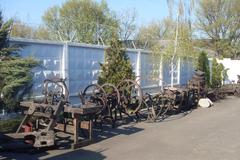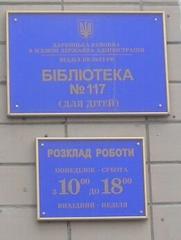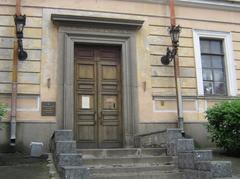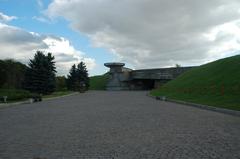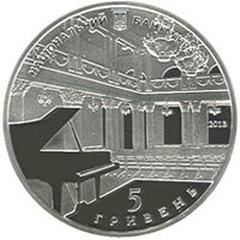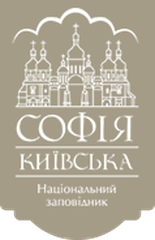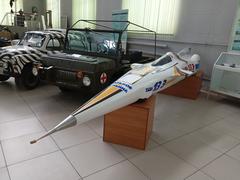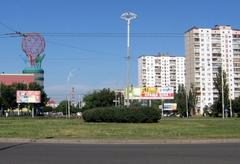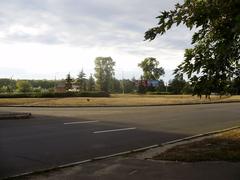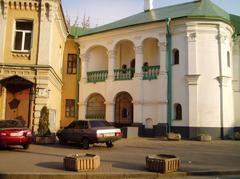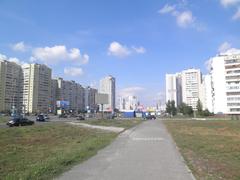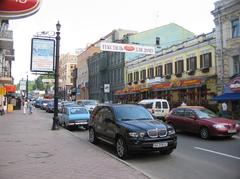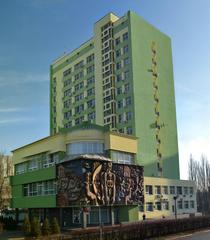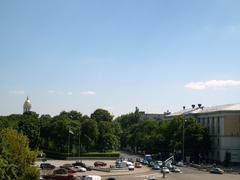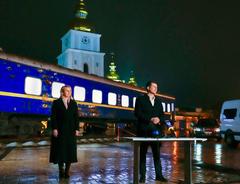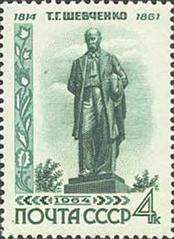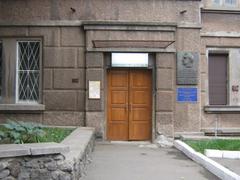Visiting the Panikovsky Statue in Kyiv: Hours, Tickets, and Cultural Significance
Date: 04/07/2025
Introduction
Located at the heart of Kyiv’s bustling center, the Panikovsky Statue is a beloved monument that fuses literature, humor, and the city’s vibrant urban culture. Commemorating Mikhail Samuelevich Panikovsky, a fictional character from the satirical Soviet novel The Little Golden Calf by Ilya Ilf and Yevgeny Petrov, this statue offers visitors a unique experience that reflects Kyiv’s multicultural past and enduring literary traditions (Wikipedia, newsukraine.rbc.ua).
Unveiled in 1998 at 6 Prorizna Street, the statue is the work of sculptors Vitaly Sivko and Vladimir Shchur. Its interactive and whimsical features—like Panikovsky’s hand “reaching” for a passerby’s pocket and the hidden symbolic fig on the shoe’s sole—invite playful engagement, making it a dynamic part of Kyiv’s urban landscape (discover-ukraine.info).
This guide provides a comprehensive overview of the Panikovsky Statue, including its historical and literary roots, practical visitor information (hours, tickets, accessibility), travel tips, nearby attractions, and essential safety considerations for modern travelers.
Table of Contents
- Literary Origins and Historical Context
- The Statue’s Creation and Symbolism
- Visiting Information: Hours, Tickets, and Accessibility
- Cultural Significance and Urban Identity
- Tips for Visitors and Nearby Attractions
- Safety and Practical Travel Advice
- Frequently Asked Questions (FAQ)
- Conclusion
- References
Literary Origins and Historical Context
Mikhail Panikovsky, immortalized in The Little Golden Calf, is a satirical figure emblematic of cunning and resourcefulness within the dynamic social landscape of 1920s Kyiv and the Soviet Union. The character, a blind beggar and pickpocket, is both a critique of Soviet society and a nod to Kyiv’s historically significant Jewish community, reflecting the city’s diversity and literary legacy (Wikipedia, newsukraine.rbc.ua).
Kyiv’s multicultural identity at the turn of the 20th century included a thriving Jewish population, particularly in the Podil district, whose influence is echoed in Panikovsky’s character. Through his escapades, Ilf and Petrov captured the essence of an era marked by social upheaval and the search for opportunity amid uncertainty (Kyiv Post).
The Statue’s Creation and Symbolism
The Panikovsky Statue was installed in 1998 at 6 Prorizna Street, central Kyiv, envisioned by sculptors Vitaly Sivko and Vladimir Shchur. The bronze statue stands nearly life-size and is modeled in part after Zinovy Gerdt, the actor who portrayed Panikovsky in the celebrated 1968 film adaptation.
Distinctive details include Panikovsky’s dark glasses, cane, and a spoon on a chain—hallmarks of his beggar disguise. His left hand appears to reach into the pocket of passersby, while his right foot hovers over a coin, symbolizing his perpetual pursuit of luck and money. A unique hidden fig sculpted on the sole of his shoe serves as a gesture of mockery—uncovered only if visitors stoop to look, humorously “bowing” to the character (discover-ukraine.info).
These playful and interactive features have made the statue a living part of Kyiv’s urban folklore, with traditions such as rubbing the shoe for good luck and mimicking Panikovsky’s pose for photos (kiev4tourists.com).
Visiting Information: Hours, Tickets, and Accessibility
- Location: 6 Prorizna Street, Kyiv, 02000
- Hours: Open-air, accessible 24/7 year-round
- Tickets: Free; no entrance fee required
- Accessibility: The statue is at street level with flat, wheelchair-accessible sidewalks
The Panikovsky Statue is within easy reach of Kyiv’s Khreshchatyk and Zoloti Vorota metro stations, with Prorizna Street itself being pedestrian-friendly and home to many popular cafes and shops.
Guided walking tours often include the statue as part of a broader exploration of Kyiv’s literary and cultural sites. While there are no dedicated Panikovsky tours, literary-themed or city art walks frequently stop here, sharing stories and local traditions (mytravelation.com).
Cultural Significance and Urban Identity
The Panikovsky Statue is unique among Kyiv’s monuments for its humor and informality, standing as a playful counterpoint to grand statues of historical figures. It serves as a cultural touchstone, reinforcing Kyiv’s openness to satire, creativity, and interactive art.
Local customs have developed around the statue—leaving coins under Panikovsky’s shoe for luck, searching for the hidden fig, and taking photos mimicking his pickpocket gesture. These rituals foster a sense of shared cultural identity and connect visitors to the city’s living traditions (discover-ukraine.info, Kyiv Post).
The statue also contributes to Kyiv’s broader landscape of whimsical monuments (such as Hedgehog in the Fog and Cat Panteleimon), highlighting the city’s creative spirit (kiev4tourists.com).
Tips for Visitors and Nearby Attractions
- Best Time to Visit: Early mornings and late afternoons offer the softest light and fewer crowds, ideal for photos.
- Photo Opportunities: Stand to the statue’s left and mimic the pickpocket gesture—a favorite among visitors.
- Nearby Sites: Independence Square (Maidan Nezalezhnosti), Khreshchatyk Street, Golden Gate, St. Sophia’s Cathedral, and other city landmarks are within walking distance.
- Amenities: The area offers numerous cafes, bars, and shops. Public restrooms are available in local establishments.
- Special Events: The statue sometimes features in city festivals and literary tours—check local event listings for details.
Safety and Practical Travel Advice
As of July 2025, Ukraine remains under martial law due to ongoing conflict. While Kyiv is generally safer than conflict zones in the east and south, visitors should:
- Install the Air Alert app for real-time notifications
- Know the locations of nearby bomb shelters (marked in metro stations and online)
- Comply with local curfews and carry identification
- Consider travel insurance covering military risks
Despite regional instability, central Kyiv’s tourist infrastructure remains robust and well-patrolled.
Frequently Asked Questions (FAQ)
Q: What are the Panikovsky Statue’s visiting hours?
A: The statue is outdoors and accessible at any time, 24/7.
Q: Is there an entrance fee or ticket required?
A: No, visiting the Panikovsky Statue is free of charge.
Q: How can I get there?
A: Located at 6 Prorizna Street, Kyiv, it is a short walk from Khreshchatyk Metro Station.
Q: Are guided tours available?
A: Yes, many walking tours include the statue as a highlight; booking ahead is recommended during festivals.
Q: Is the statue wheelchair accessible?
A: Yes, the area features flat, accessible sidewalks.
Q: What is the best time to visit?
A: Early morning or late afternoon for optimal lighting and fewer crowds.
Conclusion
The Panikovsky Statue is more than a bronze monument; it is a dynamic symbol of Kyiv’s literary legacy, humor, and cultural resilience. Its central location, interactive elements, and local traditions make it a must-see for literature lovers, history enthusiasts, and curious travelers alike. By engaging with the statue and its stories, visitors gain a deeper connection to Kyiv’s rich, multifaceted heritage.
Plan your visit today, capture your own iconic Panikovsky pose, and explore the city’s vibrant array of historical sites and cultural treasures. For more tips and updates, consider downloading the Audiala app and following Kyiv’s cultural scene online.
References
- Panikovsky Statue in Kyiv: Visiting Hours, Tickets, and Cultural Significance, Discover Ukraine
- Panikovsky Statue Kyiv: Visiting Hours, Tickets, and Cultural Significance, MyTravelation
- Visiting the Panikovsky Statue in Kyiv: Cultural Significance, Tips, and Visitor Information, Kyiv Post
- Panikovsky Statue Visiting Hours, Tickets & Kyiv Historical Sites Guide, Kyiv Maps
- The Little Golden Calf, Wikipedia
- How old is Kyiv really? Shocking look at the city’s history, RBC Ukraine
- Kyiv Monuments Guide, Kiev4Tourists
